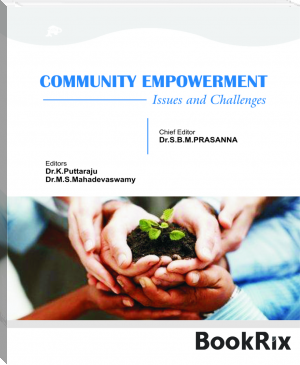Community Empowerment by Dr. SBM Prasanna, Dr. K Puttaraju, Dr.MS Mahadevaswamy (books under 200 pages TXT) 📕

Book online «Community Empowerment by Dr. SBM Prasanna, Dr. K Puttaraju, Dr.MS Mahadevaswamy (books under 200 pages TXT) 📕». Author Dr. SBM Prasanna, Dr. K Puttaraju, Dr.MS Mahadevaswamy
The king was an accomplished musician, and like his predecessors, patronised the fine arts. For these reasons, his reign is often described as the ‘Golden age of Mysore’. Krishna Raja Wadiyar was the first chancellor of Banaras Hindu University and University of Mysore. The latter was the first university chartered by an Indian State. The India Institute of Science at Bangalore which was initiated during His mother’s tenure as regent was started during his reign, with the gift, in 1911, of 371 acres (1.5 km) of land and a donation of funds. He was a parton of Indian (both Carnatic and Hindustani) and Western Classical Music.
Concept of Community Development
The United Nations defines Community development as "a process where community members come together to take collective action and generate solutions to common problems." It is a broad term given to the practices of civic leaders, activists, involved citizens and professionals to improve various aspects of communities, typically aiming to build stronger and more resilient local communities.
Role of Sri.NalwadiKrishnarajaWadiyar in Community Development
The Maharaja paid immediate attention to development programmes. Regency had become in a way become in a way make-do effort. Now that the ruler had assumed full powers, and was in a vibrant mood to do something good, he launched a series of reforms and improvements in several sectors, such as finance, irrigation, education, electrification, local self-government, city improvement board and cooperative societies. The new Dewan, P.N. Krishna Murthy, the first Mysore an to hold that office since Rendition was also enthusiastic to show his mettle that he was on par with the Madrasis and British civilians. Fortunately, a few other factors too helped the progress.
The total revenue of the State in 1902 was Rs.80 lakhs. A good part of it was spent on such useful departments as Medical, Education, Public Works, Police, Law and Justice. Every effort was made to enhance the revenue. On the suggestion of the Resident, Robertson, audit office was created with Comptroller of the State Finances as its head. This was a very important step which would audit all accounts, find fault with any wrong expenditure, and act as the custodian of the finances. An experienced officer from the Government of India was invited. With this step, accountability in the system was introduced.
More important, in the view of Maharaja, than finance was education which held the key for social change and welfare of man. He believed it should be of right type; it should help build bridges of understanding between man and man; it must make people live harmoniously and graciously with fellow beings; it should help solve basic demands of man like food, shelter and clothing; and it must provide creative vision, finer taste and nobler aims. He was aware also of the face that any knowledge that was not applied knowledge was no knowledge at all. That was why early in his reign he jumped at the idea of Tata to establish Indian Institute of Science in Bangalore which was the first of its kind in India, and which has gained world renown to-day.
Indian Institute of Science, Bangalore established in 1909
Mysore Agricultural Residential School, Bangalore, established in 1913.
University Agricultural Sciences, Banaglore was initially established in 1899 by Krishna Raja Wadiyar IV’s mother maharani Vani Vilas Sannidhana, the Regent of Mysore, with an initial grant of 30 acres as an experimental agricultural station.
University of Mysore established in 1916:
Yuvaraja College, Mysore established in 1916
School of Engineering, Bangalore later UVCE., established in 1917.
Maharani’s Science College for women, Mysore established in 1917.
Mysore Medical College, established in 1924.
Banaras Hindu University, Varanasi, First Chancellor and co-founder
In 1934, the Government of Mysore gifted 10 acre land in Bangalore to Noble laureate Sir C.V. Raman for the creation of research institute Raman Research Institute (RRI)
In order to promote both education and industry a novel experiment was undertaken on the pattern of Japan. A few selected schoolmasters were sent to Tata Silk Farm in Bangalore to get training in improved methods of growing mulberry trees, rearing silk worms and learning reeling methods. This was just for a short period of three months, but just enough to give a new orientation.
An interesting experiment was made in Local Self-Government. About 3000 people constituted a Union, which had a Chairman appointed on the recommendation of the Deputy Commissioner. Each Taluk Board was to have 12 members, four ex-officio, the Assistant Commissioner, the Amildar, the Medial officer, and the Senior Officer of the Public Works Department.
A more significant development in civic consciousness was the establishment of Mysore City Improvement Trust Board. It came into existence as early as 1903. Its aim was to provide the city with world class amenities. For this a statutory competent body was created to take care of planning. It was first to carry out an exhaustive survey of the whole city and prepare a master-plan. It was to provide all such facilities as good roads, water-supply, drainage, lighting and well-leid out quarters. Congested areas had to be removed.
After education and local self-government, attention was paid to land development. Indian economy is primarily agrarian economy. Nearly eighty per cent of the people depended on agriculture and agriculture itself depended on the vagaries of monsoons. Hence, from a long, long time, rulers of the day never ignored their responsibility to help the peasants through irrigation facilities, which were lilnked to the construction of either tanks or anicuts. Mysore State inherited from the past large number of tanks. These tanks needed repair and maintenance. Before 1904 the practice was to involve the ryots to do the earth work and the Government to do the stone work. A decision was taken in 1904 to end this practice, and make the Government do both stone-work and earth-work. The peasants were relieved of a great burden. The Government was moving in the direction of welfare State. Hardly a few years later it was to undertake the massive work of the construction of KrishnarajaSagar Dam over the river Cauvery.
Credit should go to Mysore among the Princely States for initiating Cooperative societies movement. The Maharaja took personal interest in it supporting the start of a series of societies in difference places to solve the problem of rural and urban indebtedness. He was so supportive that he placed a large sum of money from his own purse at the disposal of the Registrar of the Societies to popularize this movement.
Agriculture attracted great attention. A chemist was appointed to do a systematic study of soil in all parts of the State, to ascertain the proper manures required for difference types of soil, to suggest the removal of insects and other pests that damaged the crop, and to devise improved methods of cultivation.
In 1905 AD.the establishment of an experimental farm at Hebbal was a land mark development to promote agriculture. The seeds for green revolution of later days after independence were sown by Mysore State in starting this farm. It realized the fact that the greatest good of the largest number could be achieved only through improved technology in agriculture. To promote both agriculture and industry a novel method of holding annual Jatras or fairs was undertaken in different places of the State.
Contribution of Sri NalwadiKrishnarajaWadiyar IV to Agriculture Development
irrigation
The Hydro Electric Project at Shivanasamudra Falls in 1902. This Station was commissioned by the Diwan of Mysore, K. SeshadriIyer.
VaniVilasaSagaraChitradurga, Completed in 1907, the first dam in Karnataka state.
Krishna Raja Sagar (KRS) dam, established in 1924.
Irwin Canal: Later named as Visveshwaraiaha Canal.
Marakonahalli dam in Tumkur district Completed in 1930. The dam has an automatic siphon system, first of its kind in Asia.
electrification
Bangalore was the first city in India to get electric street lights in 1905
Mysore lamps, Bangalore, established in 1936.
Hirebhaskara dam started in 1939 across river Sharavathi to ensure steady water supply for the 120 MW Krishnarajendra Hydroelectric power station. The power station was renamed as Mahatma Gandhi Hydroelectric Project in 1949.
Factory
Mysore State Railway (MSR) between 1916 and 1918, opened 232 miles of railway to traffic. By 1938 MSR and 740 miles of railway track.
Government Sandalwood oil factory, Bangalore, established in 1917.
Wood Distillation Factor, Bhadravathi in 1918.
Mysore Chrome and Tanning Factory established in 1918.
Visvesvaraya Iron and Steel Plant (VISL, Bhadravathi was started as Mysore Iron Works in 1923.
Mysore Sugar Mills, Mandya, established in 1933.
K.R. Mils, Mysore, established in 1933
Mysore Paper Mils, Bhadravati, established in 1936
Mysore Chemical and Fertilizers Factory, Belagola established in 1937.
The Government Dichromate Factory, Belagola.
Glass and Porcelain Factories, Bangalore established in 1939.
Mysore Paints and Varnish Limited, established in 1937. It become part of the public sector in 1947.
Mysore Implements Factory, Hassan, established in 1939 to produce agricultural and garden implements.
Hindusthan Aircraft, Bangalore, established in 1940, later renamed as Hindustan Aeronautics Limited.
Contribution to other sectors
Minto Eye Hospital Bangalore, established in 1903. Is among the world’s oldest specialised ophthalmology hospital.
Mysore Legislative Council was established in 1907 with a view to associate certain number of non-official persons having practical experience and knowledge to assist the Government in Making laws and regulation.
Mysore Boy Scouts, established in 1909. First of its kind in India.
State Bank of Mysore established in 1913.
Kannada SahityaParishat, Bangalore, established in 1915.
The Mysore Chamber of Commerce established in 1916.
Krishna RajendraHostpital, Mysore, established in 1927, is attached to Mysore Medical College.
K.R. Market, Bangalore. The main wholesale market dealing with commodities in Bangalore. established in 1928.
St. Philomena’s Church, Mysore in 1933.
Vanivilas Women and Children Hospital, Bangalore, established in 1934. Named after Maharani Vani Vilas Sannidhana.
Conclusion
Thus a hectic programme was launched in sector of social life to improve the conditions of the people. Education, finance, agriculture, industry, local self-government, cooperative movement, electrification, irrigation and quite a few other areas received particular attention. In education rural and primary literacy programme and the training of the youth in arts and crafts were the main objectives. A very significant step was taken in the area of self-government when District Boards, Taluk Boards and Village Unions were set up. It was a taining at the grass root level for the people to know their own local problems and solve them. It was a kind of nursery in the art of governance. Land-survey, settlement of revenue, census, cooperative society, auditing of public income and expenditure, Mysore City Improvement Trust, promotion of agriculture and industry were all essential measures that were taken up between 1902 and 1905 AD.
References:
NalvadiKrishnarajaWadiyar Retrieved from http//kn.wikpedia-org/wiki/ KrishnarajaWodeyar IV- Retrieved from http//www.mysorelive.com/ krishnaraja-wodeyar-IV
KrishnarajaWadiyar IV. Retrived from http//en.wiki.quote.org/wiki/Krishna Raja Wadiyar IV.
Rama Jois, M. 1984. Legal and constitutional history of India ancient legal, judicial and constitutional system. Delhi: Universal Law Pub. Co. p597.
PRIORITY SECTOR LENDING OF BANKS AND FINANCIAL INCLUSION IN INDIA: AN ANALYSIS
Dr. R. Sambashivam* & Mr. Adarsha .H.R**
*Associate Professor and Co-ordinator, P.G Studies and Research in Economics, Sahyadri Arts College, Kuvempu University, Shivamogga – 577 203
**Ph.D Research Scholar, Dept. of Studies in Economics, Sahyadri Arts College, Kuvempu University, Shivamogga – 577 203
ABSTRACT
Priority sector lending and financial inclusion are positive relationship in the banking sector and always concentrating about the socioeconomic welfare of the weaker section. In this paper we are discussing the role of priority sector lending on financial inclusion. Because financial inclusion is necessary to enable the weaker section of the society to participate in the formal financial system as they are otherwise disadvantaged section and low-income groups. Priority sector lending of banks are creates more financial inclusion. This paper focusing two objectives they are. Role of priority sector lending of banks on financial inclusion in India. And impact of priority sector lending of banks on financial inclusion in India. In our study frame two hypotheses to meet the objectives they are priority sector lending of banks on financial inclusion are not significant in India, priority sector lending of banks increases more non performing assets. Finally this paper gives the major findings, suggestion and conclusion. An attempt is made in this paper to study the priority sector lending of banks and financial inclusion





Comments (0)